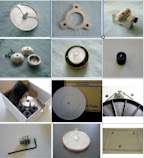By "Simple steps" to improve or upgrade Rega P1 or P2 turntables in my earlier post, I only referred to simple plug-and-play solutions using readily available parts in the market. I didn't touch on any upgrades involving "installations". But recently I came across some requests by Rega P1 users on how to improve their humble turntable further, other than just the plug-and-play upgrades....
Well, you may also try on these "not-so-simple" steps to further upgrade your Rega P1 :
1. Remove the motor from the board and place it onto a stainless steel isolation base,IB22, to isolate the motor vibration such that the motor now effectively becomes an "out-board" motor (refer to my earlier post on motor isolation base for Rega P1 ( P2,P3) for details).
2. Replace the original Rega RB100 tonearm wires with new ones (end-to-end without joints as the origin Rega wires are joined at the tonearm base and arm tube), and also provide separate earth wire to solve the humming problem associate with using the moving-iron (MI) Grado cartridges as the Rega RB100 uses one of the negative wire as earth.
Just to summarize on the complete upgrades I have done on my own unit of Rega P1 being part of my tweaking experiments:
1. Upgrade plastic end-stub and counterweight to stainless steel underslung counterweight.
2. Change the resin sub-platter to anti-resonance aluminium metal sub-platter.
3. Replace the wooden fiber platter to acrylic platter with lower centre of gravity.
4. Upgrade the Ortofon stylus to OM30e.
1. Fix the motor onto the motor isolation base (reversible).
2. Upgrade tonearm wires with separate earth ( non-reversible ).
1. Upgrade the plastic pulley to stainless steel pulley.
2. Add a 3-point stainless steel VTA spacer.
3. Aluminium feet.
If you are not upgrading your Rega P1 to higher series yet at the moment, have some fun tweaking what you have in hand. Moreover, most of the upgrades are transferable to more expensive Rega models should you decide to upgrade your humble P1 in the future, i.e. to P3-24 or P5. This is something I always like about Rega- simple, upgradeable and 'timeless'.
List of Rega upgrade accessories : Click to read more >>





















